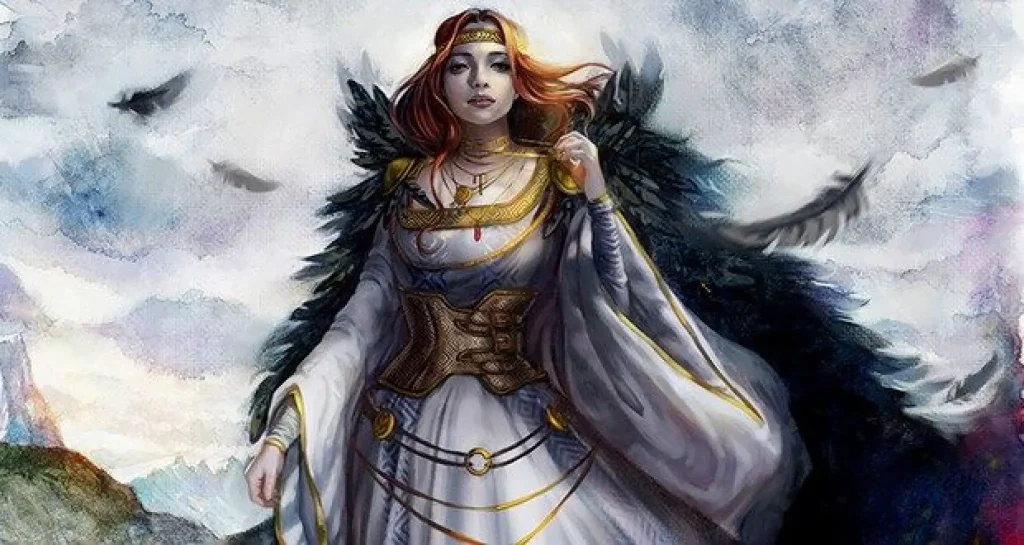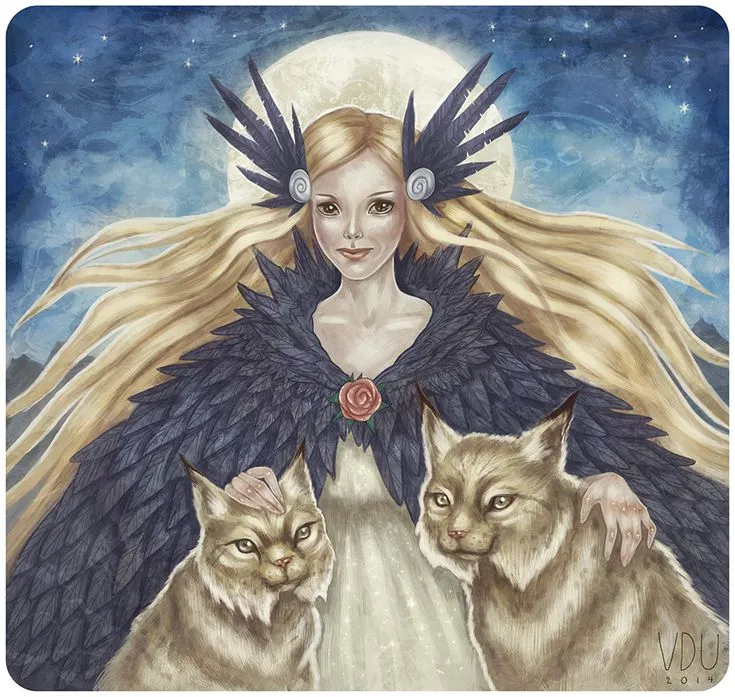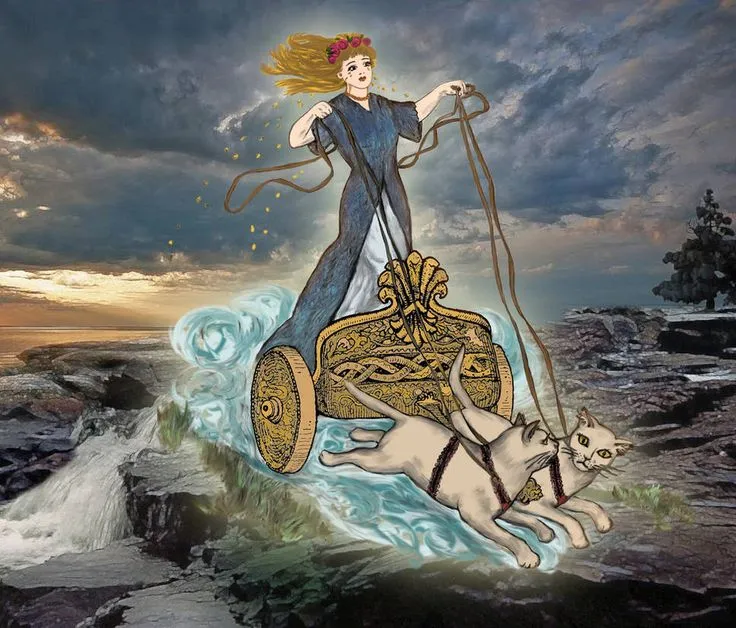Freya, also known as Freyja in Old Norse, is a prominent goddess in Norse mythology. She is known for her multifaceted character and her significance in various aspects of Norse culture. Here are some freya goddess facts about Freya:
Who is Freya God of War?
In the popular video game series “God of War,” the character Freya is a goddess of love, beauty, and fertility as she is in Norse mythology. Instead, she is depicted as a complex and multi-dimensional character who plays a prominent role in the game’s narrative.
In the “God of War” series, Freya is the mother of Baldur, one of the main antagonists, and she possesses powerful magical abilities, particularly related to healing and protection. Her character is portrayed as a protective mother who becomes entangled in the game’s events as she seeks to save her son and exact revenge on the game’s protagonist, Kratos.
The portrayal of Freya in “God of War” draws inspiration from Norse mythology but takes creative liberties to craft a unique and compelling character within the context of the game’s story and gameplay. This version of Freya has her own motivations, backstory, and character development that differ from the traditional Norse mythological depiction of the goddess Freya.


What symbolizes Freya?
Freya, the Norse goddess of love, beauty, fertility, and more, is associated with several symbols and objects in Norse mythology. Freya goddess symbols represent different aspects of her character and her domain. Some of the key symbols and associations with Freya include:
- Brisingamen Necklace: Freya is often closely associated with her prized possession, the Brisingamen necklace. This exquisite piece of jewelry, made by dwarves, is considered a symbol of her beauty and power. It plays a central role in some Norse myths.
- Cats: Cats, particularly large cats like lions and panthers, are sometimes associated with Freya. They are considered her sacred animals, and she is believed to have traveled in a chariot drawn by these animals.
- Falcon: Freya’s magical cloak made of falcon feathers allows her to transform into a falcon. The falcon is a symbol of her ability to take flight and move between different realms.
- Swan: Swans are also associated with Freya, symbolizing her grace and beauty. She is sometimes depicted with swans.
- Love and Desire: As a goddess of love, Freya’s symbols often include those associated with romance and desire. Hearts, flowers, and other symbols of love can be associated with her.
- Fertility Symbols: Symbols representing fertility, such as sheaves of wheat, are linked to Freya, reflecting her role in promoting fertility and the growth of crops.
- Seidr Staff or Wand: Freya’s connection to seidr, a form of Norse magic, may be symbolized by a staff or wand used in divination and sorcery.
These symbols collectively represent the diverse aspects of Freya’s character, from her beauty and sensuality to her role in fertility, magic, and war as the queen of the Valkyries. Each of these symbols helps to convey her multifaceted nature and her significance in Norse mythology.
What element is Freya?
In Norse mythology, the deities are not typically associated with specific elements in the same way that some other mythological traditions do. Instead, their domains and powers cover a wide range of aspects in the natural and supernatural world. Freya, as the Norse goddess of love, beauty, fertility, and more, is not specifically associated with a particular element.
However, Norse mythology itself does contain elements related to the natural world, such as the elements of earth, water, fire, and air. These elements are interconnected and play roles in various aspects of Norse cosmology and myth, but they are not directly attributed to individual deities like Freya.
Instead, Freya’s powers and attributes are tied to her role as a goddess of love, beauty, fertility, and magic, rather than any specific elemental association. Norse mythology tends to be more complex and multifaceted in its characterizations of deities, with a focus on their distinct domains and roles within the pantheon.
What Magic does Freya use?
Freya is associated with a form of Norse magic known as “seidr” or “seiðr.” Seidr is a type of sorcery or divinatory magic in Norse mythology, and Freya is one of the primary figures known for practicing it. Here are some aspects of seidr magic and how Freya might have used it:
- Divination: Seidr involves the use of divination techniques to gain insights into the past, present, and future. Practitioners, including Freya, could use seidr to obtain knowledge about events, fate, and hidden truths.
- Shape-Shifting: Seidr sometimes included the ability to shape-shift, which allowed practitioners to assume different forms. Freya was known for her shape-shifting abilities, and these may have been linked to her practice of seidr.
- Fertility Magic: Freya, as a fertility goddess, may have used seidr to influence matters related to fertility, such as the growth of crops and the conception of children.
- Healing and Protection: Seidr could also be used for healing and protection. Freya’s association with love and beauty may have included the use of seidr to bring about healing and protection in matters of the heart and relationships.
- Weather Control: Some accounts suggest that seidr could be used to control or influence the weather, which could have broader implications for the land and its fertility.
- Altered States of Consciousness: Practicing seidr often involved entering altered states of consciousness, which allowed the practitioner to access hidden knowledge or connect with other realms.
Freya’s use of seidr made her a powerful and mysterious figure in Norse mythology. This form of magic was associated with the feminine and was sometimes viewed with both awe and suspicion in the Norse world. Freya’s mastery of seidr added to her multifaceted character as a goddess of love, beauty, fertility, and magic.
What are three interesting facts about Freya?
Freya is a fascinating Norse goddess associated with love, beauty, and fertility. Here are three interesting facts about her:
- Queen of the Valkyries: Freya is often considered the queen of the Valkyries, who were mythical female warriors responsible for selecting brave warriors from the battlefield to escort them to Valhalla. This association highlights her role as a powerful and assertive deity in Norse mythology.
- Falcon Feather Cloak: According to Norse mythology, Freya had a magical cloak made of falcon feathers that allowed her to transform into a falcon. This cloak granted her the ability to fly and was an important symbol of her supernatural powers and connections to nature and animals.
- Love and Fertility Goddess: Freya was also revered as a goddess of love, beauty, and fertility. She was often called upon to assist with matters of the heart, and her connection to fertility made her a popular figure for couples seeking to conceive. She was associated with the blooming of spring and the renewal of life.
Freya’s complex character and multifaceted role in Norse mythology make her a captivating figure with a rich and diverse set of attributes and associations.


What are Freya’s powers?
In Norse mythology, Freya is a goddess with a wide range of powers and attributes. Some of her notable powers and abilities include:
- Love and Beauty: Freya is primarily known for her association with love and beauty. She possesses the power to inspire love and desire in others, making her a prominent figure in matters of romantic and sexual attraction.
- Fertility: She is also considered a fertility goddess, associated with the growth of crops and the conception of children. Her blessings were often sought by couples trying to conceive.
- Seidr Magic: Freya was skilled in the practice of seidr, a form of Norse magic associated with divination and sorcery. This made her a powerful and mysterious figure with the ability to see and influence the future.
- Shape-shifting: Freya had the power to shape-shift, and she was known to transform into various animals, including a falcon. This ability allowed her to move through the realms and observe the world from different perspectives.
- Warrior Goddess: While Freya is often associated with love and beauty, she is also a warrior goddess. As the queen of the Valkyries, she had the power to choose fallen warriors from the battlefield and take them to the afterlife, particularly to Valhalla, the hall of slain heroes in Norse mythology.
- Brisingamen Necklace: Freya possessed the famous Brisingamen necklace, which was considered a symbol of her beauty and power. This precious item was created by dwarves and was highly sought after by other beings in the Norse myths.
- Independence and Strength: Freya is often portrayed as an independent and strong-willed goddess who doesn’t hesitate to assert her desires and powers. She is a complex character with elements of both benevolence and assertiveness.
Is Freya a nice goddess?
In Norse mythology, Freya is a complex character with both benevolent and assertive aspects. Whether she is considered “nice” depends on the context and the specific myths in which she appears.
Goddess of Love and Beauty: Freya is often associated with love and beauty, and in this aspect, she is seen as a benevolent and nurturing deity. She is the patron of lovers and is known for inspiring love and desire, which can be seen as a positive and pleasing quality.
Fertility Goddess: As a fertility goddess, Freya is believed to aid in the growth of crops and the conception of children, which are essential for the well-being of communities. Her blessings in this regard are generally seen as positive.
Independent and Strong-Willed: Freya is also portrayed as a strong and assertive goddess who doesn’t hesitate to stand up for herself and assert her desires. She is known for her independence and willingness to take action to achieve her goals.
Warrior Queen: In her role as the queen of the Valkyries, she chooses fallen warriors from the battlefield and takes them to Valhalla, which can be seen as a more assertive and martial aspect of her character. While this action is necessary for the warriors to enter the hall of heroes, it involves the death of those chosen.
What are Freya’s animal signs?
In Norse mythology, Freya is associated with various animals that are considered her sacred or symbolic creatures. Some of the animals associated with Freya include:
- Cats: Cats are strongly associated with Freya. She is said to have had a special affinity for them, and they are often considered her sacred animals. It’s believed that she may have had chariot-drawn cats.
- Falcon: Freya had a magical cloak made of falcon feathers that allowed her to transform into a falcon. The falcon is a symbol of her ability to take flight and move between worlds.
- Swan: Swans are also connected to Freya and are sometimes associated with her beauty and grace.
These animals are part of the rich symbolism and mythology surrounding Freya and her various attributes, including her associations with love, beauty, fertility, magic, and the other aspects of her character.
Does Freya love Kratos?
In the “God of War” video game series, Freya’s relationship with Kratos is complex and evolves throughout the story. Initially, Freya does not love Kratos. She has a strained relationship with him, as he is involved in events that affect her son, Baldur, who is one of the main antagonists in the game. This strained relationship leads to conflict and antagonism between Freya and Kratos.
However, as the story progresses, Freya’s feelings toward Kratos change, and she comes to have a complicated mix of emotions for him. Without giving away too many spoilers, their interactions and the events of the game lead to a more nuanced portrayal of their relationship, reflecting the game’s exploration of complex themes and character development.
The “God of War” series delves into the emotional and moral dimensions of its characters, including Freya and Kratos, which adds depth to their interactions and personal growth throughout the games.ف
What is Freya’s favorite color?
There is no specific mention of Freya having a favorite color in Norse mythology or in the Eddas, which are the primary sources of information about Norse deities. As such, her favorite color is not a part of her traditional mythology or attributes. The focus in Norse mythology is generally on her roles as a goddess of love, beauty, fertility, and other aspects of her character. Any associations with specific colors would likely be a modern interpretation or personal interpretation rather than a part of the original mythological sources.
What is Freya to Thor?
In Norse mythology, Freya and Thor are two distinct deities, and they are not typically described as having a familial relationship with each other. Both Freya and Thor are prominent figures in the Norse pantheon, but they serve different roles and have distinct attributes.
Freya is a goddess associated with love, beauty, fertility, and magic. She is the daughter of the god Njord and is often considered one of the Vanir, a group of deities in Norse mythology. Freya is a complex character with various powers and associations, and she is also known for her role as the queen of the Valkyries.
Thor, on the other hand, is the god of thunder and one of the principal deities in Norse mythology. He is known for his great strength, courage, and his ability to wield the mighty hammer Mjolnir. Thor is the son of Odin, the chief god of the Norse pantheon, and is often depicted as a protector of both gods and humans.
While Freya and Thor do not have a familial relationship, they do interact in various Norse myths and share some common associations within the pantheon. For instance, both are associated with fertility, as Thor was often invoked to bless marriages and ensure the fertility of crops. They also have connections to the concept of fertility, but their roles and domains are distinct in Norse mythology.
Who is Freya’s husband?
In Norse mythology, Freya is married to a figure named Óðr (sometimes spelled “Od” or “Odr”). Óðr is a somewhat mysterious and enigmatic character, and his name is often translated as “mind” or “spirit,” suggesting that he represents a more abstract concept.
The exact nature of Óðr is not extensively detailed in surviving Norse mythological texts, and his role is not as well-documented as some other deities. However, it’s clear that Freya and Óðr were a couple, and their relationship is alluded to in various myths and stories.
One of the most well-known myths involving Freya and Óðr is the story of Freya’s grief when Óðr goes missing, which is a central theme in the myth of the necklace of the Brisings. In this myth, Freya’s longing for her husband is a significant element of the narrative.
While Óðr’s character and attributes are not as fully developed as those of other Norse gods and goddesses, he is traditionally recognized as Freya’s husband in Norse mythology.

